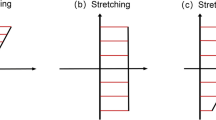Abstract
Springback due to the elastic material behaviour can lead to shape errors that cause geometrical and dimensional inaccuracies in sheet metal forming processes, especially in bending operations. In order to reduce springback, the technique of integrating stretching with bending in sheet metal forming processes has been investigated. The object of this paper is to explain how to reduce the effect of the elastic component in the material behaviour using simultaneous stretching and bending so that a method is established for applying plastic forming during the main process, without changing the tool design. This study focuses on three main points: the stretching method, the stretching direction and the stretching length. In regard to swing- and v-bending processes, the springback factor is used as the standard evaluation to investigate these effects using Finite Element simulation. The springback factors are compared for four processes: Bending process without stretching (WS), pre-stretching and bending process (PB), pre-stretching plus simultaneous stretching and bending (PSB) and simultaneous stretching and bending (SB). The simulation results are then verified through experimentation. Based on the validated results, simultaneous stretching can then be subsequently applied to the existing stretch-forming process, which consists of pre-stretching and bending. Using this process, springback was successfully reduced which confirms the efficiency of SB process.











Similar content being viewed by others
References
Yi K, Choi K, Kim N, Botkin M (2007) Design sensitivity analysis and optimization for minimizing springback of sheet-formed part. Int J Numer Methods Eng 71:1483–1511
Oliveria M, Alves J, Chaparro B, Menezes L (2007) Study on the influence of work-hardening modeling in springback prediction. Int J Plast 23:516–543
Cheng H, Cao J, Xia Z (2007) An accelerated springback compensation method. Int J Mech Sci 49:267–279
Carden W, Geng L, Matlock D, Wagoner R (2002) Measurement of springback. Int J Mech Sci 44:79–101
Geng L, Wagoner R (2002) Role of plastic anisotropy and its evolution on springback. Int J Mech Sci 44:123–148
Li X, Yang Y, Wang Y, Bao J, Li S (2002) Effect of the material-hardening mode on the springback simulation accuracy of V-free bending. J Mater Process Technol 123:209–211
Yoshida F, Uemori T (2003) A model of large-strain cyclic plasticity and its application to springback simulation. Int J Mech Sci 45:1687–1702
Yanagimoto J, Oyamada K (2007) Mechanism of springback-free bending of high-strength steel sheets under warm forming conditions. CIRP Ann 56:265–268
Wenner M (1983) On work hardening and springback in plane strain draw forming. J Appl Metalwork 2:277–287
Liu Y (1988) The effect of restraining force on shape deviation in flanged channels. J Eng Mater Technol 110:389–394
Altan T (1998) Metal forming handbook /Schuler. Springer, Berlin
Yang M, Akiyama Y, Sasaki T (2004) Evaluation of change in material properties due to plastic deformation. J Mater Process Technol 151:232–236
Papeleux L, Ponthot J (2002) Finite element simulation of springback in sheet metal forming. J Mater Process Technol 125–126:785–791
Clausen A, Hopperstad O, Langseth M (2001) Sensitivity of model parameters in stretch bending of aluminum extrusions. Int J Mech Sci 43:427–453
Sachs G (1951) Principles and methods of sheet-metal fabricating. Reinhold, New York
Acknowledgements
The investigations presented in this paper have been performed with support of the Deutsche Forschungsgemeinschaft (German Research Foundation).
Author information
Authors and Affiliations
Corresponding author
Rights and permissions
About this article
Cite this article
Schilp, H., Suh, J. & Hoffmann, H. Reduction of springback using simultaneous stretch-bending processes. Int J Mater Form 5, 175–180 (2012). https://doi.org/10.1007/s12289-011-1031-1
Received:
Accepted:
Published:
Issue Date:
DOI: https://doi.org/10.1007/s12289-011-1031-1




